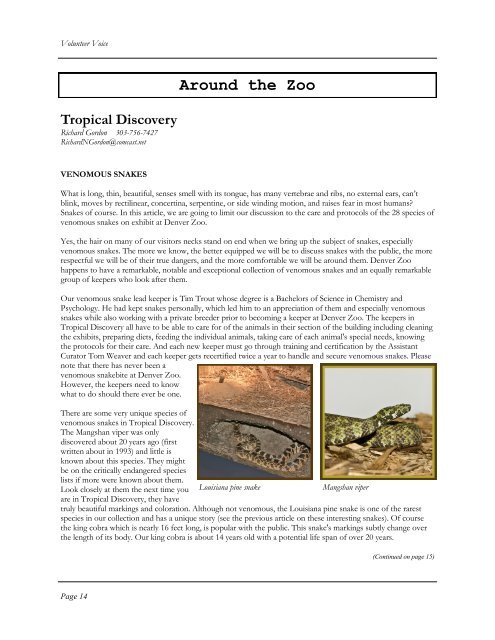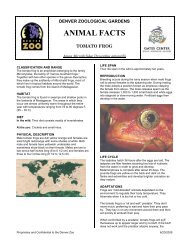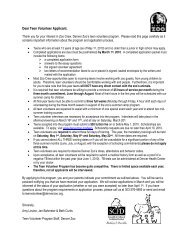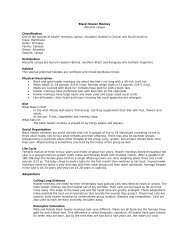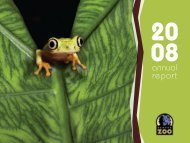VOLUNTEER VOICE October 2013 In This Issue... - Denver Zoo
VOLUNTEER VOICE October 2013 In This Issue... - Denver Zoo
VOLUNTEER VOICE October 2013 In This Issue... - Denver Zoo
Create successful ePaper yourself
Turn your PDF publications into a flip-book with our unique Google optimized e-Paper software.
Volunteer VoiceAround the <strong>Zoo</strong>Tropical DiscoveryRichard Gordon 303-756-7427RichardNGordon@comcast.netVENOMOUS SNAKESWhat is long, thin, beautiful, senses smell with its tongue, has many vertebrae and ribs, no external ears, can’tblink, moves by rectilinear, concertina, serpentine, or side winding motion, and raises fear in most humans?Snakes of course. <strong>In</strong> this article, we are going to limit our discussion to the care and protocols of the 28 species ofvenomous snakes on exhibit at <strong>Denver</strong> <strong>Zoo</strong>.Yes, the hair on many of our visitors necks stand on end when we bring up the subject of snakes, especiallyvenomous snakes. The more we know, the better equipped we will be to discuss snakes with the public, the morerespectful we will be of their true dangers, and the more comfortable we will be around them. <strong>Denver</strong> <strong>Zoo</strong>happens to have a remarkable, notable and exceptional collection of venomous snakes and an equally remarkablegroup of keepers who look after them.Our venomous snake lead keeper is Tim Trout whose degree is a Bachelors of Science in Chemistry andPsychology. He had kept snakes personally, which led him to an appreciation of them and especially venomoussnakes while also working with a private breeder prior to becoming a keeper at <strong>Denver</strong> <strong>Zoo</strong>. The keepers inTropical Discovery all have to be able to care for of the animals in their section of the building including cleaningthe exhibits, preparing diets, feeding the individual animals, taking care of each animal's special needs, knowingthe protocols for their care. And each new keeper must go through training and certification by the AssistantCurator Tom Weaver and each keeper gets recertified twice a year to handle and secure venomous snakes. Pleasenote that there has never been avenomous snakebite at <strong>Denver</strong> <strong>Zoo</strong>.However, the keepers need to knowwhat to do should there ever be one.There are some very unique species ofvenomous snakes in Tropical Discovery.The Mangshan viper was onlydiscovered about 20 years ago (firstwritten about in 1993) and little isknown about this species. They mightbe on the critically endangered specieslists if more were known about them.Look closely at them the next time youare in Tropical Discovery, they haveLouisiana pine snakeMangshan vipertruly beautiful markings and coloration. Although not venomous, the Louisiana pine snake is one of the rarestspecies in our collection and has a unique story (see the previous article on these interesting snakes). Of coursethe king cobra which is nearly 16 feet long, is popular with the public. <strong>This</strong> snake's markings subtly change overthe length of its body. Our king cobra is about 14 years old with a potential life span of over 20 years.(Continued on page 15)Page 14


